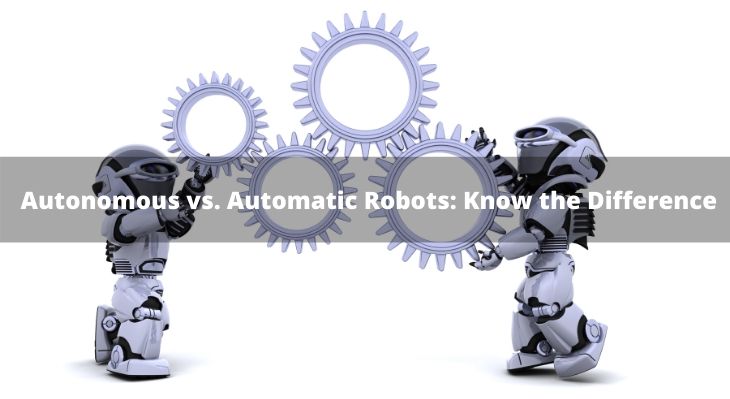Complex series of actions were reduced for humans in many ways with the introduction of robots in daily tasks.
Over the course of the last few years, with the advancement in robotic technology, a classification has been done amongst the robots based upon their functionality.
These were so divided according to their technical nature as autonomous and automatic robots.
The main difference between autonomous and automatic robots lies in the amount of human intervention in the processes of both.
Autonomous can be defined as the robotic technology which is able to respond to the real world with minimal human intervention. This intervention part may involve the initialization of robot-like switching it on.
Whereas automatic robots are largely dependent on human intervention when it comes to doing various sets of tasks.
These human interventions may range from guiding the robot along its route or predefining the complete process for it.
Here we will be discussing the difference between both autonomous and automatic robots on the basis of their usages, types, components, and various real-life examples that we’ve in use.
Autonomous robots can nowadays be seen mostly being used in large warehouses wherein they have been successful at reducing the workload of human labor.
They help carry large and heavy goods across the warehouse. They are also useful at loading and unloading of the goods without any error.
Automatic robots on the other hand can be seen doing mostly repetitive sets of tasks. These can be seen in the manufacturing industries, mostly helping with tasks related to the part transfer, welding, painting, cutting, etc.
Autonomous robots are classified into 4 different sets of robots.
Programmable Automatic Robot
These types of robots are re-programmable on the basis of tasks that they have been or are going to be trusted with. The job functions and the program change as the task changes.
Non- Programmable Automatic Robot
As the name defines itself these types of robots can’t be reprogrammed as they are programmed only for a specific task.
Robotic arms used in industries can be termed as the best examples of such type of autonomous robots
Adaptive Robots
These types of industrial robots are called so because of their technical properties of getting reprogramed for a specific task.
After evaluating the task it has been designed to perform it is able to perform the task in the adapted area.
Intelligent Robots
These types of robots can mostly be found in armed forces, medical and certain home appliances as well.
These types of robots are known to be intelligent because of their technical superiority over others, as they are capable of vision, hearing as well as sensory reflection.
The automatic robot type can be classified on the basis of the below-mentioned points.
Remote-controlled robots
These types of robots, dependent on human commands are controlled via remotes from a distance as well.
These types of robots are further classified into two more types which are wired remote control robots and wireless remote control robots.
Manually Controlled robot
These types of robots are controlled directly via manual controls fastened with robotic setup.
Autonomous robots consist of below-mentioned components:
Self-maintenance
The self-maintenance concept in autonomous robots suggests that the robot should be able to take its own care irrespective of what the situations might be.
In self-maintenance robots, the concept is very simple that robots should be able to evaluate their own status and take corrective measures accordingly.
For example, if a robot senses that its battery needs to be recharged it will quickly seek a charger.
Autonomous Navigation
The concept behind this component of autonomous robots is that it should be able to detect its position and should be able to navigate to an endpoint.
Earlier robots were updated with CAD floor panels which robots will follow but currently, the advancement is undergoing so that robots become self-sufficient in making their own maps to navigate.
Sensing the environment
An autonomous robot should be efficient enough to understand the environment around it.
It should be equipped with appropriate sensors that would help it to do so. Senses like altitude measurement, sense of smell, and touch are needed to make autonomous robots this efficient.
Automatic robots consist of below-mentioned components:
Actuators
A robot to perform a specific action like humans should be equipped with actuators.
These actuators are small motors that are responsible for helping a robotic machine to be able to mimic the action by allowing it to move its parts.
Power Supply
Automatic robots to perform any task are dependent on either battery or other electricity sources for a charge. The robots are designed in certain manners to be able to connect themselves with the power source.
Some of the robots extract their power from battery whereas some are designed like stationary robotic arms that derive their power from external power storage systems.
End Effectors
These tools help robots to interact with their nearby environments.
Roomba, a vacuum cleaner is an example of an autonomous robot.
This robot intelligently detects the barriers in its path while going about its job of cleaning. It’s a computerized vacuum cleaner that is capable of operating by itself without any human interaction.
An example of an automatic robot can be presented by Industrial Cartesian Coordinate Robot which is used on CNC lathe production lines for the loading and unloading.
It is completely dependent on computer programs that define its position accuracy. These values can further be changed according to the job requirement.
Conclusion
Robots were introduced to mankind in order to reduce their hefty workloads. But it’s still a long way for robots to become completely self-sufficient with zero interaction of humans in their working.
You may also like to read:
Know more about Robot-As-A-Service: The new Business Model
What is Robotic Process Automation? What are RPA Applications?

